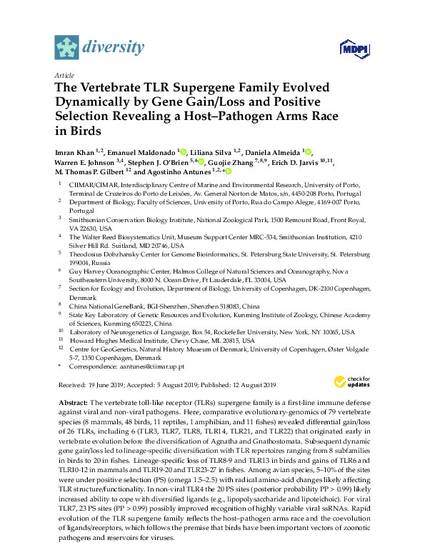
- Gene gain,
- Gene loss,
- Vertebrates,
- Toll-like receptors,
- Immune response,
- Host-pathogen,
- Positive selection
- Biology and
- Life Sciences
The vertebrate toll-like receptor (TLRs) supergene family is a first-line immune defense against viral and non-viral pathogens. Here, comparative evolutionary-genomics of 79 vertebrate species (8 mammals, 48 birds, 11 reptiles, 1 amphibian, and 11 fishes) revealed differential gain/loss of 26 TLRs, including 6 (TLR3, TLR7, TLR8, TLR14, TLR21, and TLR22) that originated early in vertebrate evolution before the diversification of Agnatha and Gnathostomata. Subsequent dynamic gene gain/loss led to lineage-specific diversification with TLR repertoires ranging from 8 subfamilies in birds to 20 in fishes. Lineage-specific loss of TLR8-9 and TLR13 in birds and gains of TLR6 and TLR10-12 in mammals and TLR19-20 and TLR23-27 in fishes. Among avian species, 5–10% of the sites were under positive selection (PS) (omega 1.5–2.5) with radical amino-acid changes likely affecting TLR structure/functionality. In non-viral TLR4 the 20 PS sites (posterior probability PP > 0.99) likely increased ability to cope with diversified ligands (e.g., lipopolysaccharide and lipoteichoic). For viral TLR7, 23 PS sites (PP > 0.99) possibly improved recognition of highly variable viral ssRNAs. Rapid evolution of the TLR supergene family reflects the host–pathogen arms race and the coevolution of ligands/receptors, which follows the premise that birds have been important vectors of zoonotic pathogens and reservoirs for viruses.
Available at: http://works.bepress.com/stephen-obrien/707/

©2019 by the authors. Licensee MDPI, Basel, Switzerland. This article is an open access article distributed under the terms and conditions of the Creative Commons Attribution (CC BY) license (http://creativecommons.org/licenses/by/4.0/).